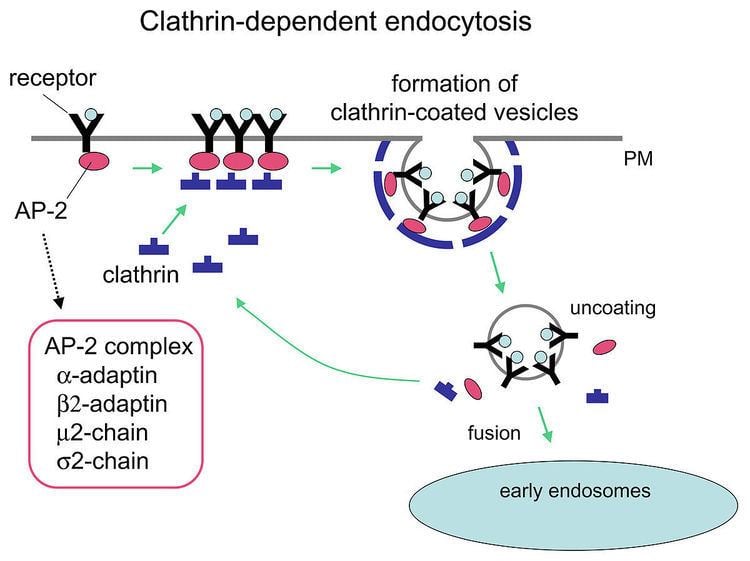Receptor Mediated Endocytosis: Unlocking Cellular Uptake Mechanisms

Receptor Mediated Endocytosis: Unlocking Cellular Uptake Mechanisms

Receptor-mediated endocytosis (RME) is a vital cellular process that enables cells to internalize molecules, such as proteins, lipids, and other nutrients, from the external environment. This complex process involves the coordination of multiple molecular players, including receptors, adaptors, and vesicular structures, to facilitate the uptake of essential molecules. In this article, we will delve into the intricacies of RME, exploring its mechanisms, regulation, and significance in cellular physiology.
What is Receptor-Mediated Endocytosis?

Receptor-mediated endocytosis is a type of endocytosis that involves the binding of molecules to specific receptors on the cell surface. This binding event triggers a series of molecular interactions that ultimately lead to the internalization of the molecule-receptor complex. RME is a highly regulated process that ensures the selective uptake of essential molecules while preventing the entry of harmful substances into the cell.
Mechanisms of Receptor-Mediated Endocytosis

The RME process involves several key steps, including:
- Binding of molecules to receptors: Molecules in the external environment bind to specific receptors on the cell surface, triggering a conformational change in the receptor.
- Recruitment of adaptors and accessory proteins: The activated receptor recruits adaptor proteins, such as AP-2, and accessory proteins, such as clathrin, to the site of endocytosis.
- Formation of clathrin-coated pits: The recruitment of clathrin and other proteins leads to the formation of clathrin-coated pits on the cell surface.
- Internalization of the molecule-receptor complex: The clathrin-coated pit invaginates, and the molecule-receptor complex is internalized into the cell.
- Uncoating and vesicle formation: The clathrin coat is removed, and the internalized molecule-receptor complex is transported to endosomes and lysosomes for further processing.
Regulation of Receptor-Mediated Endocytosis

RME is a highly regulated process that involves the coordinated action of multiple signaling pathways. Key regulators of RME include:
- Phosphorylation and dephosphorylation events: Phosphorylation and dephosphorylation events play critical roles in regulating receptor activity and adaptor protein recruitment.
- Ubiquitination and deubiquitination events: Ubiquitination and deubiquitination events regulate receptor degradation and recycling.
- Signaling pathways: Signaling pathways, such as the PI3K/AKT pathway, regulate RME by modulating receptor activity and adaptor protein recruitment.
Significance of Receptor-Mediated Endocytosis

RME plays a vital role in maintaining cellular homeostasis and regulating various cellular processes, including:
- Cell growth and survival: RME regulates the uptake of essential nutrients, such as amino acids and glucose, required for cell growth and survival.
- Cell signaling and communication: RME regulates the internalization of signaling molecules, such as hormones and growth factors, that modulate cellular behavior.
- Immune response and inflammation: RME regulates the uptake of pathogens and immune complexes, which is critical for the immune response and inflammation.
🔍 Note: RME is a highly regulated process that is critical for maintaining cellular homeostasis. Dysregulation of RME has been implicated in various diseases, including cancer, neurodegenerative disorders, and infectious diseases.
Therapeutic Targeting of Receptor-Mediated Endocytosis

RME has emerged as a promising therapeutic target for various diseases. Strategies to modulate RME include:
- Small molecule inhibitors: Small molecule inhibitors that target RME regulators, such as kinases and ubiquitin ligases, have been developed to modulate RME.
- RNA interference (RNAi) therapy: RNAi therapy has been used to knockdown RME regulators and modulate RME.
- Nanoparticle-based delivery systems: Nanoparticle-based delivery systems have been developed to exploit RME for targeted delivery of therapeutics.
💡 Note: Therapeutic targeting of RME requires a deep understanding of the underlying mechanisms and regulatory pathways. Further research is needed to fully exploit the therapeutic potential of RME.
In conclusion, receptor-mediated endocytosis is a complex cellular process that plays a vital role in maintaining cellular homeostasis and regulating various cellular processes. Understanding the mechanisms and regulation of RME is essential for developing therapeutic strategies to modulate RME and treat various diseases.
What is the primary function of receptor-mediated endocytosis?

+
The primary function of receptor-mediated endocytosis is to facilitate the internalization of essential molecules, such as proteins, lipids, and nutrients, from the external environment.
What are the key regulators of receptor-mediated endocytosis?

+
The key regulators of receptor-mediated endocytosis include phosphorylation and dephosphorylation events, ubiquitination and deubiquitination events, and signaling pathways, such as the PI3K/AKT pathway.
What are the therapeutic strategies to modulate receptor-mediated endocytosis?

+
Therapeutic strategies to modulate receptor-mediated endocytosis include small molecule inhibitors, RNA interference (RNAi) therapy, and nanoparticle-based delivery systems.